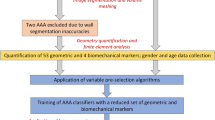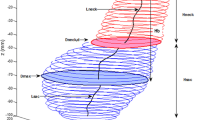Abstract
An abdominal aortic aneurysm (AAA) carries one of the highest mortality rates among vascular diseases when it ruptures. To predict the role of surface curvature in rupture risk assessment, a discriminatory analysis of aneurysm geometry characterization was conducted. Data was obtained from 205 patient-specific computed tomography image sets corresponding to three AAA population subgroups: patients under surveillance, those that underwent elective repair of the aneurysm, and those with an emergent repair. Each AAA was reconstructed and their surface curvatures estimated using the biquintic Hermite finite element method. Local surface curvatures were processed into ten global curvature indices. Statistical analysis of the data revealed that the L2-norm of the Gaussian and Mean surface curvatures can be utilized as classifiers of the three AAA population subgroups. The application of statistical machine learning on the curvature features yielded 85.5% accuracy in classifying electively and emergent repaired AAAs, compared to a 68.9% accuracy obtained by using maximum aneurysm diameter alone. Such combination of non-invasive geometric quantification and statistical machine learning methods can be used in a clinical setting to assess the risk of rupture of aneurysms during regular patient follow-ups.








Similar content being viewed by others
References
Batchelor, P. G., A. D. Castellano Smith, D. L. Hill, D. J. Hawkes, T. C. Cox, and A. F. Dean. Measures of folding applied to the development of the human fetal brain. IEEE Trans. Med. Imaging 21:953–965, 2002.
Brady, A. R., S. G. Thompson, F. G. Fowkes, R. M. Greenhalgh, and J. T. Powell. Abdominal aortic aneurysm expansion: risk factors and time intervals for surveillance. Circulation 110(1):16–21, 2004.
Fillinger, M. F., S. P. Marra, M. L. Raghavan, and F. E. Kennedy. Prediction of rupture risk in abdominal aortic aneurysm during observation: wall stress versus diameter. J. Vasc. Surg. 37:724–732, 2003.
Giannoglou, G., G. Giannakoulas, J. Soulis, Y. Chatzizisis, T. Perdikides, N. Melas, et al. Predicting the risk of rupture of abdominal aortic aneurysms by utilizing various geometrical parameters: revisiting the diameter criterion. Angiology 57:487–494, 2006.
Greenhalgh, R. M., L. C. Brown, G. P. Kwong, J. T. Powell, and S. G. Thompson. Comparison of endovascular aneurysm repair with open repair in patients with abdominal aortic aneurysm (EVAR trial 1), 30-day operative mortality results: randomised controlled trial. Lancet 364:843–848, 2004.
Holt, P. J. E., J. D. Poloniecki, I. M. Loftus, J. A. Michaels, and M. M. Thompson. Epidemiological study of the relationship between volume and outcome after abdominal aortic aneurysm surgery in the UK from 2000 to 2005. Br. J. Surg. 94(4):441–448, 2007.
Kultangwattana, W., K. Somkantha, and P. Phuangsuwan. Diagnosis of the abdominal aorta aneurysm in magnetic resonance imaging images. World Acad. Sci. Eng. Technol. 53:648, 2009.
Lederle, F. A., S. E. Wilson, G. R. Johnson, D. B. Reinke, F. N. Littooy, et al. Immediate repair compared with surveillance of small abdominal aortic aneurysms. N. Engl. J. Med. 346:1437–1444, 2002.
Leung, J., R. D. Nyilas, S. M. L. Ng, and X. Y. Xu. Towards a new geometric approach to assess the risk of rupture of abdominal aortic aneurysms using patient specific modeling. In: Proceedings of the 2005 Summer Bioengineering Conference. Abstract SBC2005-I21.
Limet, R., N. Sakalihasan, and A. Albert. Determination of the expansion rate and the incidence of rupture of abdominal aortic aneurysms. J. Vasc. Surg. 14:540–548, 1991.
Ma, B., R. E. Harbaugh, and M. L. Raghavan. Three-dimensional geometrical characterization of cerebral aneurysms. Ann. Biomed. Eng. 32:264–273, 2004.
Mark, H., F. Eibe, H. Geoffrey, P. Bernhard, R. Peter, and H. W. Ian. The WEKA data mining software: an update. SIGKDD Explor. 11(1):10–18, 2009.
Martufi, G., E. S. Di Martino, C. H. Amon, S. C. Muluk, and E. A. Finol. Three-dimensional geometrical characterization of abdominal aortic aneurysms: image-based wall thickness distribution. J. Biomech. Eng. 131(6):061015, 2009.
Nielsen, P. M. F., I. J. Le Grice, B. H. Smaill, and P. J. Hunter. Mathematical model of geometry and fibrous structure of the heart. Am. J. Physiol. 260:1365–1389, 1991.
Pappu, S., A. Dardik, H. Tagare, and R. J. Gusberg. Beyond fusiform and saccular: a novel quantitative tortuosity index may help classify aneurysm shape and predict aneurysm rupture potential. Ann. Vasc. Surg. 22:88–97, 2008.
Prakash, S., and C. R. Ethier. Requirements for mesh resolution in 3D computational hemodynamics. J. Biomech. Eng. 123(2):134–144, 2001.
Raghavan, M. L., B. Ma, and R. E. Harbaugh. Quantified aneurysm shape and rupture risk. J. Neurosurg. 102:355–362, 2005.
Sacks, M. S., C. J. Chuong, G. H. Templeton, and R. Peshock. In vivo 3-D reconstruction and geometric characterization of the right ventricular free wall. Ann. Biomed. Eng. 21:263–275, 1993.
Sacks, M. S., D. A. Vorp, M. L. Raghavan, M. P. Federle, and M. W. Webster. In vivo three-dimensional surface geometry of abdominal aortic aneurysms. Ann. Biomed. Eng. 27:469–479, 1999.
Sakalihasan, N., R. Limet, and O. D. Defawe. Abdominal aortic aneurysm. Lancet 365(9470):1577–1589, 2004.
Sander, P. T., and S. W. Zucker. Inferring surfaces trace and differential structure from 3-D images. IEEE Trans. Pattern Anal. Mach. Intell. 12(9):833–854, 1990.
Scott, R. A. P., H. A. Ashton, M. J. Buxton, N. E. Day, L. G. Kim, T. M. Marteau, S. G. Thomspon, N. M. Walker, and M. A. S. Stu. The Multicentre Aneurysm Screening Study (MASS) into the effect of abdominal aortic aneurysm screening on mortality in men: a randomised controlled trial. Lancet 360(9345):1531–1539, 2002.
Shum, J., E. S. Di Martino, A. Goldhammer, D. Goldman, L. Acker, G. Patel, G. Martufi, and E. A. Finol. Semi-automatic vessel wall detection and quantification of wall thickness in CT images of human abdominal aortic aneurysms. Med. Phys. 37:638–648, 2010.
Shum, J., G. Martufi, E. Di Martino, C. B. Washington, J. Grisafi, S. C. Muluk, and E. A. Finol. Quantitative assessment of abdominal aortic aneurysm geometry. Ann. Biomed. Eng. 39(1):277–286, 2011.
Smith, D. B., M. S. Sacks, D. A. Vorp, and M. Thornton. Surface geometric analysis of anatomic structures using biquintic finite element interpolation. Ann. Biomed. Eng. 28:598–611, 2000.
The UK Small Aneurysm Trial Participants. Mortality results for randomized controlled trial of early elective surgery or ultrasonographic surveillance for small abdominal aortic aneurysms. Lancet 352:1649–1655, 1998.
Venkatasubramaniam, A. K., M. J. Fagan, T. Mehta, K. J. Mylankal, B. Ray, G. Kuhan, I. C. Chetter, and P. T. McCollum. A comparative study of aortic wall stress using finite element analysis for ruptured and non-ruptured abdominal aortic aneurysms. Eur. J. Vasc. Surg. 28:168–176, 2004.
Acknowledgments
The authors would like to acknowledge research funding from the Korean Government Scholarship Program for Study Overseas, and the Vlahakis Graduate Fellowship program. This work was also funded in part by NIH grants R21EB007651, R21EB008804 and R15HL087268. The content is solely the responsibility of the authors and does not necessarily represent the official views of the National Institutes of Health. The authors would like to thank Drs. Michael Sacks and David Smith for their insightful discussions on the basics of the BQFE method and its implementation for surface curvature analysis.
Author information
Authors and Affiliations
Corresponding author
Additional information
Associate Editor Scott L. Diamond oversaw the review of this article.
Appendices
Appendix I: Definition of Global Curvature Features (i.e., Geometric Indices)
Area of a Triangular Element
where the final points of \( \overset{\lower0.5em\hbox{$\smash{\scriptscriptstyle\rightharpoonup}$}}{a}_{i} \) and \( \overset{\lower0.5em\hbox{$\smash{\scriptscriptstyle\rightharpoonup}$}}{b}_{j} \) share one edge of the triangle.
Gaussian and Mean Curvatures
The roots of Eqs. (3) and (8) are defined as the local (nodal) curvatures, \( k_{1i} \) and \( k_{2i}. \) The local Gaussian (K) and Mean (M) curvatures are given by
Global Curvature Indices (Calculation Described in Detail by Martufi et al. 13)
- KG :
-
Square root sum of the Gaussian curvature
- KM :
-
Square root sum of the Mean curvature
- GAA :
-
Area averaged Gaussian curvature
- MAA :
-
Area averaged Mean curvature
- K1AA :
-
Area averaged major principal curvature
- K2AA :
-
Area averaged minor principal curvature
- GLN :
-
L2 norm of the Gaussian curvature
- MLN :
-
L2 norm of the Mean curvature
- K1LN :
-
L2 norm of the major principal curvature
- K2LN :
-
L2 norm of the minor principal curvature
Appendix II: Brief Description of Curvature Estimation by BQFE Interpolation
A BQFE interpolation has C 2 continuity on the surface on which curvatures are probed by having the first and second derivatives defined at the surface nodes such that BQFE derived curvatures are more accurate than those computed with lower order continuity methods. To calculate curvatures directly from BQFE, we use Eq. (8) and the subsequent tensor products:
where \( b_{\alpha \beta } = \sqrt {g_{\theta \theta } g_{\theta z} - g_{\theta z}^{2} } \left| {\begin{array}{*{20}c} {X_{\alpha \beta } } & {Y_{\alpha \beta } } & {Z_{\alpha \beta } } \\ {X_{\theta } } & {Y_{\theta } } & {Z_{\theta } } \\ {X_{z} } & {Y_{z} } & {Z_{z} } \\ \end{array} } \right| \) and \( g_{\alpha \beta } = X_{\alpha } X_{\beta } + Y_{\alpha } Y_{\beta } + Z_{\alpha } Z_{\beta } . \)
The subscripts of X, Y, and Z represent differentiation with respect to that variable. Equations (9)–(11) demonstrate how the mathematical descriptors of the BQF elements and the corresponding Cartesian coordinates of the surfaces are related to each other:
where \( 2\omega \pi /\left( {Z_{\hbox{max} } + Z_{\hbox{min} } } \right) \), \( a_{k} \) and \( b_{j} \) are constants, and k and j are the number of terms in the Fourier series used to represent the longitudinal AAA axis. For example, the derivatives with respect to \( {{\uptheta}} \) and z in the X direction are given by
The radial coordinate R is the fitted variable and its derivatives are expressed in terms of the element shape functions N which are biquintic hermite shape functions:
A more detailed calculation is presented by Smith et al.25
Rights and permissions
About this article
Cite this article
Lee, K., Zhu, J., Shum, J. et al. Surface Curvature as a Classifier of Abdominal Aortic Aneurysms: A Comparative Analysis. Ann Biomed Eng 41, 562–576 (2013). https://doi.org/10.1007/s10439-012-0691-4
Received:
Accepted:
Published:
Issue Date:
DOI: https://doi.org/10.1007/s10439-012-0691-4




